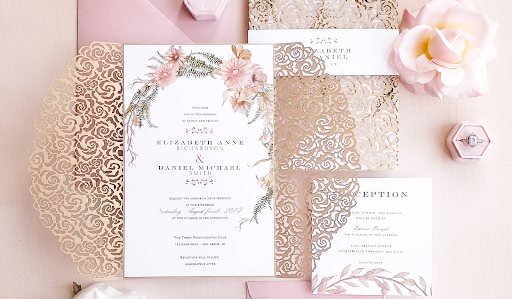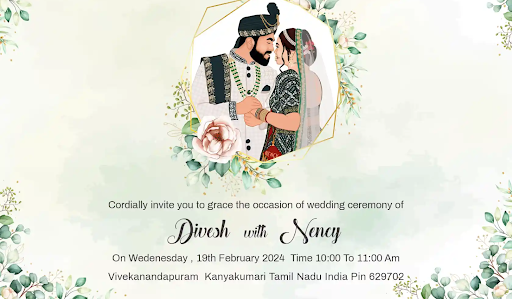Introduction
Planning a wedding is a monumental task, and one of the most critical aspects of this process is managing the invitations. From creating your guest list to handling RSVPs, every step in the invitation process can be streamlined with a bit of organization and foresight. If you’re feeling overwhelmed, fear not.

1. Start Early: The Power of Planning Ahead
The foundation of a successful invitation process starts with early planning. Begin drafting your guest list as soon as possible. This not only gives you ample time to finalize the list but also helps you avoid last-minute changes that can cause unnecessary stress.
Action Steps:
- Draft a Preliminary List: Include everyone you think you might want to invite. You can always trim down later.
- Organize Details: Use a spreadsheet or an app to keep track of names, addresses, and additional details like dietary restrictions or plus-one requests.
2. Budget Wisely: Know Your Limits
Wedding invitations can quickly add up, especially when you factor in printing, postage, and potential extras like envelope liners or custom designs. Setting a budget will help you make informed decisions and prevent overspending.
Action Steps:
- Determine Your Budget: Decide how much you’re willing to spend on invitations, including printing and mailing costs.
- Explore Options: Look at various styles and designs to find something within your budget. DIY invitations can be a cost-effective alternative if you’re crafty.
3. Choose a Style That Reflects Your Wedding
Your invitations set the tone for your wedding, so it’s important to choose a style that aligns with your wedding’s theme and formality. Whether your wedding is formal, casual, or themed, your invitations should give guests a glimpse of what to expect.
Action Steps:
- Select a Design: Consider the colour scheme, font, and overall aesthetic that matches your wedding theme.
- Be Consistent: Ensure the style of the invitation complements other wedding elements like save-the-dates, programs, and thank-you cards.
4. Proofread: The Devil Is in the Details
There’s nothing worse than discovering a mistake on your invitations after they’ve been printed and sent. To avoid this, proofread carefully and get a second pair of eyes on the final draft.
Action Steps:
- Check Details: Confirm that all names, dates, times, and addresses are correct.
- Have a Review Buddy: Ask a friend or family member to proofread for any errors you might have missed.

5. Timing Is Everything: Send Invitations on Schedule
Sending invitations at the right time ensures that your guests have ample time to make arrangements and respond. Here’s a basic timeline to follow:
Action Steps:
- Save-the-Dates: These should go out 6-8 months before your wedding. This allows guests to mark their calendars and make any necessary travel arrangements.
- Formal Invitations: Aim to send these 2-3 months before the wedding date. This gives guests enough time to RSVP and plan accordingly.

6. Streamline RSVPs with Modern Tools
Managing RSVPs can be a daunting task, but modern tools can make it easier. Online RSVPs and wedding websites offer a convenient way for guests to respond and provide additional information.
Action Steps:
- Set Up Online RSVPs: Use wedding websites or RSVP management tools to collect responses efficiently.
- Follow-up: For guests who don’t respond by the deadline, a polite follow-up call or email can help ensure you have an accurate headcount.

7. Prepare for Changes: Flexibility is Key
Even with the best planning, changes are inevitable. Whether it’s a change of address or last-minute additions to the guest list, being prepared for adjustments will help keep things running smoothly.
Action Steps:
- Update Lists: Keep your guest list and addresses up-to-date with any changes.
- Order Extras: Have a few extra invitations on hand for any last-minute additions or corrections.
8. Consider Eco-Friendly Options
In today’s environmentally conscious world, many couples are opting for eco-friendly invitation options. From recycled paper to digital invitations, there are plenty of ways to reduce your environmental footprint.
Action Steps:
- Explore Green Options: Look into eco-friendly paper or digital invitation alternatives.
- Communicate Preferences: If you choose digital invites, make sure to communicate this clearly to avoid confusion.
9. Track Sent Invitations and Responses
Keeping track of which invitations have been sent and which guests have responded is crucial for managing your guest list and seating arrangements.
Action Steps:
- Maintain a Checklist: Use a spreadsheet or app to track sent invitations, RSVPs, and any special requests.
- Update Regularly: As responses come in, keep your list current to ensure accurate planning.
10. Plan for the Wedding Day: The Final Touches
On the day of the wedding, having a plan for handling last-minute changes or managing guests will help ensure a smooth experience.
Action Steps:
- Create a Seating Chart: Based on RSVPs, develop a seating chart to avoid any confusion at the reception.
- Have a Backup Plan: Be prepared for any unexpected issues, such as last-minute additions or seating changes.
11. Send Thank-You Notes: Show Your Appreciation
After the wedding, sending thank-you notes to your guests is a thoughtful way to express your gratitude for their attendance and gifts. It’s also an opportunity to reflect on the special day.
Action Steps:
- Start Early: Begin writing thank-you notes soon after the wedding to keep them manageable.
- Personalize: Include a personal note to express your appreciation for each guest’s attendance and any specific gifts they may have given.
Conclusion
Managing wedding invitations might seem overwhelming at first, but with careful planning and organization, the process can be both manageable and enjoyable. By starting early, budgeting wisely, and utilizing modern tools, you’ll set the stage for a smooth invitation process that complements your beautiful day. Remember, the key is to stay organized and flexible, so you can focus on celebrating with your loved ones.

